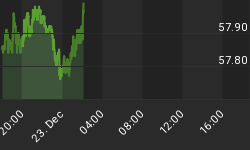With all the mock rapt attention directed to the hush-hush-what's-the-Fed-going-to-say statement that followed the ¼% rate hike Tuesday, there was a puzzling ending to the affair that says a lot about what's really happening on Planet Wall Street.
At the appointed hour of 2:15 eastern time May 3rd, 2005, the Fed announced its eighth consecutive ¼ pt. increase in the Fed Funds rate. This move of course was widely expected. The drama was attached to what the Fed would say in its statement to follow.
For months now the Fed has made clear its intention to continue interest rate increases at a "measured pace." These two words have become the holy grail of so-called Fed transparency, the supposedly wise policy of giving market players clear signals of the Fed's future intentions; this so risk-takers won't be caught offside. The last thing the Fed wants is for the highly leveraged speculating community to lose big and throw the fragile U.S. markets into confusion or worse.
Six weeks ago, the Fed once again included in its statement the hallowed verbiage that interest rate increases will continue at this "measured pace." They also slipped in new language hinting at greater evidence of inflation as a result of energy cost increases, and in their next breath blunted inflation concerns by saying that long-term inflation expectations remained "well contained."
Now, to the most recent Fed oracle. As the trading day wore on Tuesday, and the Fed's statement drew closer scrutiny, commentators noticed that, although once again, there had been an acknowledgement of inflation pressures mounting, the Fed said nothing comforting along the lines that long-term inflation expectations were "well contained."
As the recognition of this change in the statement grew, the market's small post-announcement pop was aborted, and the major averages were sinking into the close. Then lo and behold, with a bare five minutes to go before the market closed, the Fed issued a correction - they had "inadvertently omitted" the part of the statement about long-term inflation expectations being "well contained."
And, guess what? Stocks shot higher, the Dow Industrials leaping 45 points to close in barely positive territory.
It stretches credulity beyond the breaking point to believe the Fed left anything out of their statement inadvertently. As ludicrous as it is, the wordings of these Fed pronouncements have become the most closely examined data points in the U.S. economy. It would seem only too "transparent" that the Fed's original version wasn't playing according to script without the "long-term inflation well-contained" phrase.
So they had to try that little "inadvertent" stunt. Talk about transparency! What's becoming ever more apparent is that the heavy hand of the government/financial establishment combine is managing public perception of issues affecting our capital markets. Perhaps this is most apparent in the obviously distorted inflation numbers from the Bureau of Labor Statistics. All this can only end badly for the American economy and the millions of honest, hard-working families who haven't a clue that such stuff goes on.
What's most absurd of all is that yesterday's tawdry carnival act is representative of America's "free-market" economy. Yes, it's free down on Main St, where folks are free to work their hearts out to support their families and offer good products and services to their customers. But on Wall St it's looking less and less like anything close to a free market. It's a financial game, with the spoils of wealth going to - for now let's just call them well-connected "operators."
This is the natural progression of a central bank fiat money system. Over time it decays into the socialist Orwellian quicksand that it is. Back in the Soviet Union's heyday, some petty commissar would sit around reading Paris and London newspapers to figure the price for socks in Moscow's stores. Today, our masters of finance examine the entrails of the Fed's latest pronouncement to decide whether to buy or sell stocks.
Friends, most of us have some reasonable idea of what free-market capitalism is all about, and this isn't even close.
















